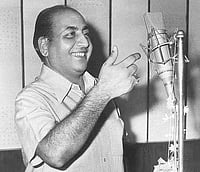I was editing Me magazine for DNA when I first met Akshay Manwani. He was researching for a book on Sahir Ludhianvi, he said, and wondered if I had inputs to share beyond what I had written in my book about his work in Pyaasa. He told me too that he had given up his corporate job to write this book, and I remember the sharp feeling of empathy and admiration that his statement evoked. Almost four years later, Manwani presented me with his book.
Biographies are a tricky business. Depending on the writer and the material he has at hand, the result could be anything between a painting with light and shade or colour and a doodle that teases and leaves the reader wanting more. Manwani, however, has crafted a sculpture. Using the clay of interviews, records, other published material and his own comments, he ensures his Sahir stands tall among his contemporaries, eyes ablaze with a passion that alternately speaks of his socialistic fervour and a series of unsuccessful romances. And of course, his poems embellish his stance, set like jewels in the telling of the story of his life.
Manwani himself borders on the lyrical at times, especially in the early chapters, which recount the story of the poet’s angst-wrought childhood, his tumultuous school and college years, where history and circumstance and the presence of fair, unattainable maidens fuelled his imagination and first gave it utterance in the form of poetry. The later chapters are more factual, but the wealth of information packed into them ensures one does not quite notice the change in tone.
Tracing Sahir’s growth as a poet, Manwani trails him from Ludhiana to Lahore to Delhi and Bombay, filling in details of his growing involvement with the Progressive Writers Movement, nationalism and the poetry that reflected his patriotic fervour even as it rang out against social injustice. The scene then shifts from the trauma of Partition to the poet as aspiring songwriter for Hindi films. Few other lyricists can boast of as considerable a body of private poems as Sahir. But he deployed the technique even in his films of using nature to personify love or the beloved, or even to paint an emotion (Yeh raat yeh chandni phir kahan from Jaal).
Sahir’s partnership with S.D. Burman, which ended in a tiff, his attempt to prove himself superior to music directors and singers, his long and successful stint with Yash Chopra films form other interesting segments. Perhaps Manwani’s most remarkable achievement is the chapter on Amrita Pritam, one of the two important women in the poet’s life. Based on interviews with Pritam’s partner, Imroz, and her own writing, Manwani lets us peep into an intriguing but very real relationship between the two poets. Sahir’s relationship with Sudha Malhotra, for whom he wrote the best songs she sang for films, is also discussed. But overriding these, and other, liaisons is the insight from Manwani’s interview of Imroz and Javed Akhtar that it was the poet’s fear of unrequited love and his overwhelming regard and emotional debt to his mother that prevented him from commitment to any woman, who thus stopped with being just his Muse.


























